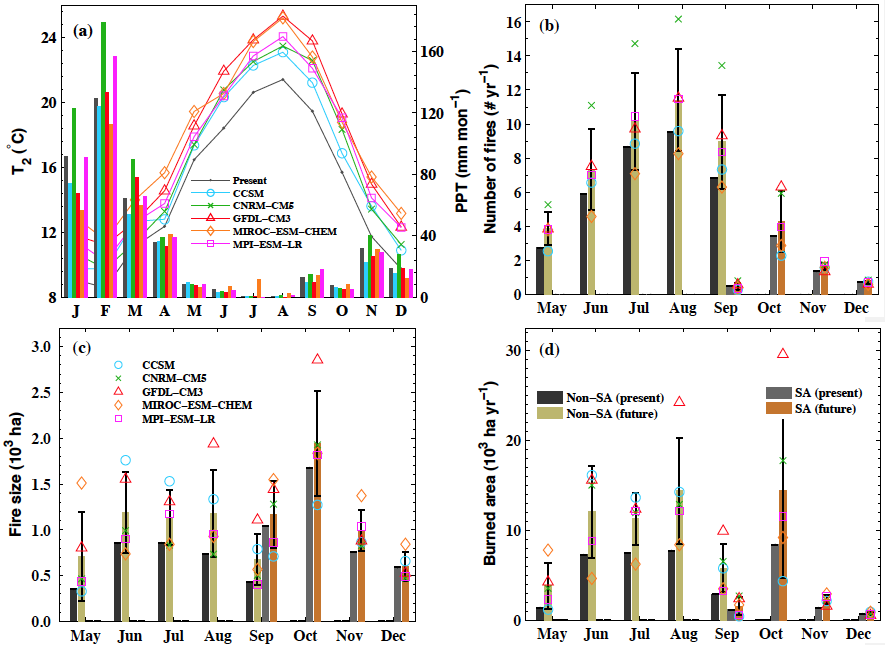Wildland Fires
Interactions between wildfire, climate, and vegetation
Climate, fuel load, fuel connectivity, human ignition, and the occurrence of extreme weather are considered the primary drivers of fire regime in California, but the relative importance of these factors is still being debated.
Intensified burn severity by warmer and drier climatic conditions in Northern California's Coastal Mountains
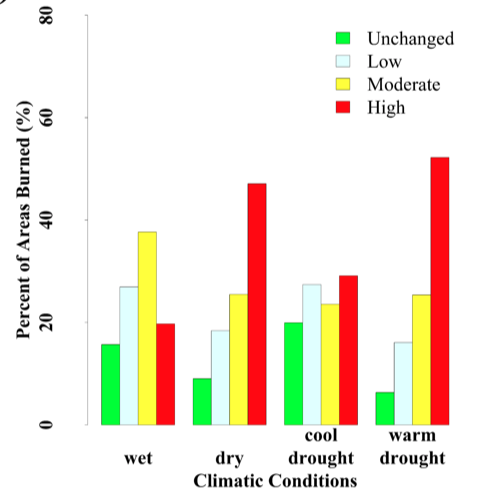 We examine the fine-scale association between burn severity and a suite of environmental drivers including explicit fuel information, weather, climate, and topography, for diverse ecosystems in California’s northern coastal mountains. We found a significant increasing trend in burned areas and severity. During low-precipitation years, areas that burned had much lower fuel moisture and higher climatic water deficit than in wetter years, and the percentage of high-severity burn areas doubled, especially during the most recent 2012-2016 drought. Topography, fuel characteristics, and temperature were the most important drivers determining burn severity, based on machine learning model analysis. During warm and dry years, the spatial variability of burn severity was a mixed effect of slope, long-term minimum temperature, fuel amount, and fuel moisture. In contrast, climatic water deficit and short-term weather became dominant factors for fires during wetter years.
We examine the fine-scale association between burn severity and a suite of environmental drivers including explicit fuel information, weather, climate, and topography, for diverse ecosystems in California’s northern coastal mountains. We found a significant increasing trend in burned areas and severity. During low-precipitation years, areas that burned had much lower fuel moisture and higher climatic water deficit than in wetter years, and the percentage of high-severity burn areas doubled, especially during the most recent 2012-2016 drought. Topography, fuel characteristics, and temperature were the most important drivers determining burn severity, based on machine learning model analysis. During warm and dry years, the spatial variability of burn severity was a mixed effect of slope, long-term minimum temperature, fuel amount, and fuel moisture. In contrast, climatic water deficit and short-term weather became dominant factors for fires during wetter years.
Our findings highlight the importance of targeting areas with high burn severity risk for fire adaptation and mitigation strategies in a changing climate and intensifying extremes.
Related publications:
Huang, Y., Y. Jin, M. Schwartz, and J. Thorne (2020), Intensified burn severity in California’s northern coastal mountains by drier climatic condition, Environmental Research Letter, in press.
Drivers for rapid wildfire progression
Variability in fire behavior is heavily influenced by dynamic and often complex interactions between meteorological and biophysical components. Humans also affects wildfire characteristics directly via fire suppression and indirectly via fuel management. We here used a machine learning approach to investigate what factors caused the rapid spread of large wildfires in the recent decade, over five distinct ecoregions in California.
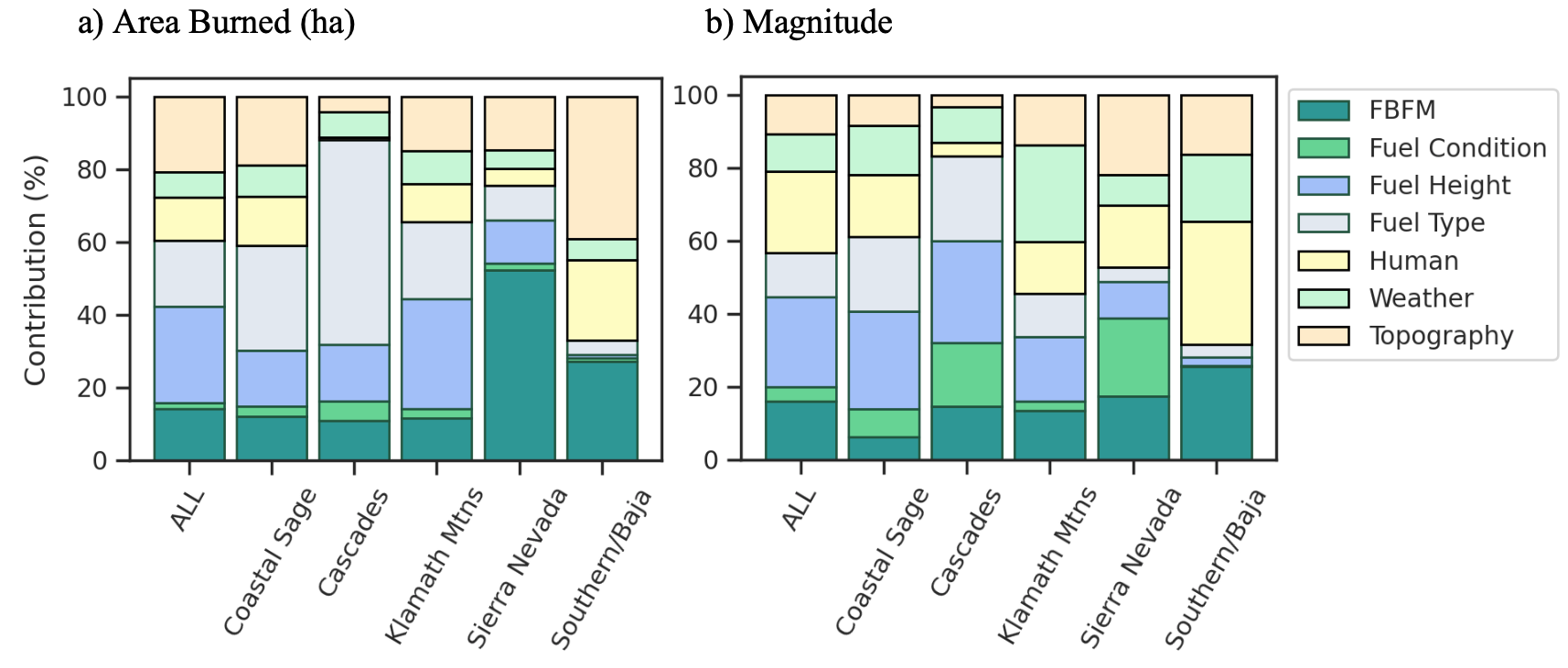 Continuous daily fire spread and area burned were derived from MODIS and VIIRS active fire products. The gradient boosting machine learning model explained 75% of variability in area burned and 63% of variability in the magnitude of spread at the daily time scale. Model diagnosis also showed the different drivers for fire spread across regions statewide. Fuel height, along with fuel-based characteristics were key determinants for large areal burns in the Klamath Mountains and Sierra Nevada, contributing to about a third of the total model gain. Whereas, weather and topography in high elevation montane regions. In the Southern/Baja region, increased area burned and magnitude were predominantly driven by high wind events.
Continuous daily fire spread and area burned were derived from MODIS and VIIRS active fire products. The gradient boosting machine learning model explained 75% of variability in area burned and 63% of variability in the magnitude of spread at the daily time scale. Model diagnosis also showed the different drivers for fire spread across regions statewide. Fuel height, along with fuel-based characteristics were key determinants for large areal burns in the Klamath Mountains and Sierra Nevada, contributing to about a third of the total model gain. Whereas, weather and topography in high elevation montane regions. In the Southern/Baja region, increased area burned and magnitude were predominantly driven by high wind events.
The results from this study provide insights on the efficacy of fuel management on reducing the rate of fire progression across ecologically diverse regions and help communities and managers to better anticipate and mitigate future risk of fast moving wildfires in the coming decades.
Contrasting controls for wind-driven wildfires
We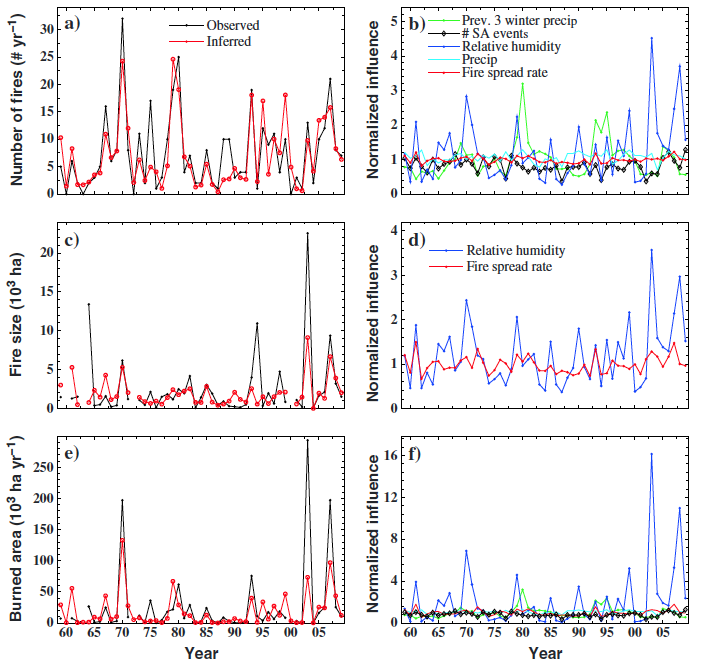 systematically partitioned fires in Southern California into two distinct types, those coincident with and without Santa Ana events, and developed separate fire-meteorology models to represent the seasonal and interannual variations for Santa Ana and non-Santa Ana fires. Our analysis shows that these two types of fire exhibit distinct spatial patterns and the dominant controls vary with fire types, opening the possibility of further targeting management strategy based on local fire regime.
systematically partitioned fires in Southern California into two distinct types, those coincident with and without Santa Ana events, and developed separate fire-meteorology models to represent the seasonal and interannual variations for Santa Ana and non-Santa Ana fires. Our analysis shows that these two types of fire exhibit distinct spatial patterns and the dominant controls vary with fire types, opening the possibility of further targeting management strategy based on local fire regime.
Related publications:
.Faivre, N., Y. Jin, M. L. Goulden, and J. T. Randerson (2014), Modeling the spatial pattern of wildfire ignitions in Southern Californian Mediterranean ecosystems, International Journal of Wildland Fire. [PDF]
Radiative forcing of fire-induced albedo change

Wildland fire is a primary dirver for vegetation dynamics, carbon cycling, and surface energy exchange, by altering vegetation structure, albedo, surface temperature, and evapotranspiration, in many ecosystems. The integrated net effects at a landscape scale depends on fire regime, including the area and severity, local climate (e.g., snow season), and the processes that influence post-fire vegetation succession.
We used historical fire perimeter data and time series of satellite observations to examine how burn severity affected vegetation recovery and albedo change dring early succession in boreal North America, and quantify how the radiative forcing varied as a function of snow season length and post-fire vegetation recovery along a boreal ecoclimatic transect. Our studies found that fires reduce surface net radiation considerably for many boreal ecosystems, and also highlighted the importance of considering vegetation-mediated impacts of fire disturbance in managing these forests for climate change mitigation.
Related Publications:
Jin, Y., J. T. Randerson, M. L. Goulden, and S. J. Goetz (2012), Post-fire changes in net shortwave radiation along a latitudinal gradient in boreal North America, Geophysical Research Letters, 39, L13403, doi:10.1029/2012GL051790.
Jin, Y., J. T. Randerson, S. J. Goetz, P. S. A. Beck, M. M. Loranty, and M. L. Goulden (2012), The influence of burn severity on post-fire vegetation recovery and albedo change during early succession in North American boreal forests, Journal of Geophysical Research-Biogeosciences, 117, G01036, doi:10.1029/2011JG001886.
Loranty, M. M., L. T. Berner, S. J. Goetz, Y. Jin, and J. T. Randerson (2013), Vegetation controls on northern high latitude snow-albedo feedback, Global Change Biology, 20(2), 594-606, doi: 10.1111/gcb.12391.
Beck, P. S. A., S. J. Goetz, M.C. Mack, H.D. Alexander, Y. Jin, J. T. Randerson, and M. M. Loranty (2011), The impacts and implications of an intensifying fire regime on Alaskan boreal forest composition and albedo, Global Change Biology, 17, 2853–2866. doi: 10.1111/j.1365-2486.2011.02412.x
Lyons, E.A., Y. Jin, and J.T. Randerson (2008), Changes in surface albedo after fire in boreal forest ecosystems of interior Alaska assessed using MODIS satellite observations, Journal of Geophysical Research-Biogeosciences, vol. 113, G02012, doi:10.1029/2007JG000606.
Jin, Y., and D.P. Roy (2005), Fire-induced albedo change and its radiative forcing at the surface in northern Australia, Geophysical Research Letters, 32(13), L13401, doi:10.1029/2005GL022822.
Socio-economic impacts of California's wildfire
Santa Ana and non-Santa Ana fires 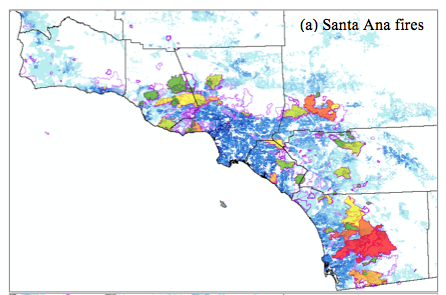 contributed almost equally to burned area, yet SA fires were responsible for 80% of cumulative economic losses during 1990-2009 ($3.1 Billion). The westward expansion towards the urbanized coastal zone, higher fire spread rate, and greater intensity of SA fires were probably the main drivers of the disproportionate economic impact of this fire type. Non-SA fires were comparatively more sensitive to age-dependent fuels; these fires often occurred in higher elevation forests, lasted for extended periods, and accounted for 70% of total suppression costs. An improved distinction of fire type has implications for management and future projections.
contributed almost equally to burned area, yet SA fires were responsible for 80% of cumulative economic losses during 1990-2009 ($3.1 Billion). The westward expansion towards the urbanized coastal zone, higher fire spread rate, and greater intensity of SA fires were probably the main drivers of the disproportionate economic impact of this fire type. Non-SA fires were comparatively more sensitive to age-dependent fuels; these fires often occurred in higher elevation forests, lasted for extended periods, and accounted for 70% of total suppression costs. An improved distinction of fire type has implications for management and future projections.
![]()
Related Publication:
Jin, Y., M. L. Goulden, N. Faivre, S. Veraverbeke, F. Sun, A. Hall, M. S. Hand, S. Hook, and J. T. Randerson (2015), Identification of two distinct fire regimes in Southern California: implications for economic impact and future change, Environmental Research Letters, 10(9), doi: 10.1088/1748-9326/10/9/094005.
Future fire projections
